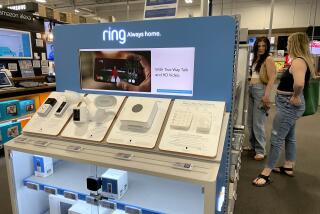Are You Talkin’ to Me?
- Share via
Somewhere in Sweden a robot vacuum is scuttling beneath a dining table. A continent away, a Korean homeowner is using the videophone on his refrigerator. And, in Japan, technicians are teaching toilet seats to measure blood pressure.
As a new generation of “smart” appliances (those that digitally store and share information) are embraced by consumers overseas, U.S. companies are pushing harder to move American households out of the century of iceboxes and washboards.
One of the most dramatic efforts is targeted for the Playa Vista development near Marina del Rey, where the first of a suite of intelligent appliances from Whirlpool are to be installed this autumn. Ultimately targeted at the general market, this collection includes an Internet-enabled refrigerator, microwave, convection oven and dishwasher.
The high-tech refrigerator will fill its traditional role as a bulletin board for family memos, calendars and shopping lists, displaying information on a bracket-mounted wireless Web tablet loaded with household planning software. The wireless tablet, which can be removed and used from anywhere in the home, connects with the other appliances and can be used remotely to set their controls and monitor their status or service needs. It can also be used as a Web browser for downloading device-specific cooking and washing instructions to be posted online by Whirlpool.
“This is not just technology for technology’s sake,” says Ken Agid, Playa Vista vice president of marketing. “In terms of energy conservation, networked appliances can minimize peak loads. If you decide you’d like to cook a thick slab of bacon in your microwave, that device can send a message to the refrigerator saying, ‘Don’t go into your high-energy ice cube manufacturing,’ and to the washer, ‘Suspend the spin cycle 45 seconds while I cook these puppies.’ ”
Smart appliances can also be programmed to do the tasks during low-rate periods when residents are sleeping or out. They can assist with their own maintenance, performing diagnostics, and e-mail the user if they pinpoint a part that needs replacing.
Using embedded bar-code scanning technology, your refrigerator, he says, could maintain a user-defined inventory, compile grocery lists or suggest menus for which all ingredients are present.
Although only a handful of people call Playa Vista home, the population is expected eventually to swell to 15,000 or more. “We’ve got the wires in the walls and the [digital] signal in the streets,” Agid says. “We actually have more cable connecting the signal than is currently needed.” In Playa Vista parlance, this sort of preparedness is known as “future-proofing.”
Not everyone in the “smart living” business agrees that such infrastructure is necessary. Herman Cardenas, founder and CEO of GE Smart, a joint venture of General Electric and Microsoft, believes existing technology can be retrofitted.
“Your dishwasher, range and refrigerator, all already connect at the load box,” he says. “So why force anyone to build a separate network when you’ve already got one?” Using a digital signal superimposed over standard wires carrying electricity, GE Smart automates home lighting, temperature and security.
More conventional Web-based technology is also being employed. Incoming telephone calls, Cardenas says, can now be routed directly to GE Smart speakers throughout the house each with its own memory and unique Internet address.
“When you pick up the phone and realize it’s a call you want to share with your family, you’ll tell the speaker, ‘open call,’ and then you’ll hear the voice traveling anywhere you go in the home. The speakers can triangulate your position to find out where that is.”
The integration of voice-command technology into domestic systems is not unique to GE. The Italian Turboair Group has created a stove hood with speech-recognition capabilities, and the British bathroom manufacturer Twyford has endowed a prototype toilet with a voice-activated flushing mechanism. There are also smart appliances that do the talking themselves. Sweden’s Electrolux (maker of the robotic vacuum) is offering Indian consumers the “Washy Talky,” a washing machine that prompts users with cues like “drop detergent, close lid and relax” in English or Hindi. And in Maryland, Home Automated Living provides software that not only recognizes and obeys voice commands, but also speaks back. (You might tell your computer to turn off the lights; the computer will tell you that the task has been accomplished.) The company markets this interface under the not-quite-reassuring acronym HAL.
Similarly fanciful, if sometimes impractical, leaps of the imagination have characterized the smart appliance industry, Cardenas says. Concept products trotted out at trade shows in the late 1990s were often little more than attention-grabbing pipe dreams. With exasperation, he refers to the Web-operated blender he saw at a show a year ago. “Am I supposed to turn on my blender over the Internet not knowing whether my kid has his hand in it or not?”
For people who are overwhelmed by digital innovations, Playa Vista is creating what Agid describes as “an optional course of continuing education that allows people to understand how to live in this advanced community.” Even dyed-in-the-wool analog throwbacks may be swayed after seeing neighbors enjoying the advantages of a wired lifestyle. “Technology,” he says, “is contagious.”
But GE Smart’s Cardenas says consumers don’t want to learn about the technology. “And,” he adds, “they shouldn’t have to.” Products that require minimal instruction or investment and retrofittable technology, he believes, are the keys to making smart homes succeed. “There are already some lower-priced products out there,” he says, referring to $150 Internet radios or similarly priced digital picture frames displaying whatever online image the user selects. “Think about that one,” he says. “Just a push of a button and you could put the in-laws’ picture up before they come by. Anyone could enjoy that!”
More to Read
Inside the business of entertainment
The Wide Shot brings you news, analysis and insights on everything from streaming wars to production — and what it all means for the future.
You may occasionally receive promotional content from the Los Angeles Times.










